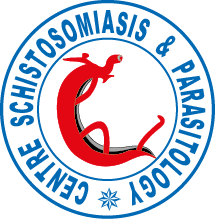Experimental evidence of hybrid breakdown between the two geographical strains of Schistosoma intercalatum
Abstract
Reciprocal crosses (Schistosoma intercalatum male Zaire×S. intercalatum female Cameroon: S. intercalatum female Zaire×S. intercalatum male Cameroon) were produced in 10 mice by exposing each mouse to 60 male cercariae of one isolate and 60 female cercariae of the other isolate, and vice versa. Hybrid generations originating from the two crosses were established. The infectivity of the F1, F2, F3 and F4 hybrid generations were evaluated after exposing snails individually to 5 miracidia. A comparative histological study of snails infected with F2 and F4 hybrid sporocysts from both crosses was made to assess abnormalities in the intramolluscan development of the hybrids. The worm recovery rate and fecundity were measured by comparing the fitness of the mid-parents with that of the hybrids. S. intercalatum Cameroon was compatible with Bulinus forskalii and incompatible with B. globosus whereas S. intercalatum Zaire was compatible with B. globosus and incompatible with B. forskalii. In the case of S. intercalatum male Cameroon×S. intercalatum female Zaire, hybrid miracidia develops in both B. forskalii and B. globosus in F1, F2 and F3 generations. The infection rate was much lower for B. globosus and F2 and F3 generations produced few cercariae (less than 30 cercariae in overall per snail) and F4 miracidia were only infective to B. forskalii again producing few cercariae. At 40 days post-infection the sporocyst contains masses of acidophilic granules originating from the breakup of pycnotic nuclei. Similarly the F1, F2 and F3 miracidia of the reciprocal cross (S. intercalatum male Zaire×S. intercalatum female Cameroon) exhibited a dual infectivity for B. forskalii and B. globosus, but cercarial productivity was low (less than 30 cercariae overall per snail for F2 and F3 generations). Histological studies demonstrated sporocyst degeneration in snails infected with F4 generation. In the definitive host, the F1 generation (both crosses) exhibited hybrid vigour in that the worm return was greater than that of the mid-parent, F2 and F3 generations. No significant difference in fecundity was demonstrated between the parental strains and the F1 and F2 generations, yet egg production of the F3 generation was significantly lower. It is apparent that there is a post-zygotic barrier in the crosses of S. intercalatum Zaire and S. intercalatum Cameroon from the F2 generations onwards, and sterility of the F4 hybrid sporocyst supports the concept of the existence of 2 distinct taxa.
